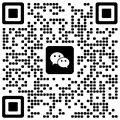IOT Data Services Provided by IOT EMS Platform
Abstract: Acrel IoT EMS platform is a platform based on Acrel IoT data center, which has established uplink and downlink data standards to provide Internet users with energy IoT data services. Acrel IoT EMS is a centralized online platform for connecting all acrel networking products. It offers unified access, monitoring and control capabilities, which saves time and allows you to oversee your whole networking fleet. If your acrel device is on IoT EMS, it can be used to generate remote access links to equipment that is connected to 4G or wifi network. Once an alarm event occurs,within a few seconds, relevant alarm and event information will be quickly pushed through the APP to notify relevant person.
Key words: IoT; energy management system; IoT meter; cloud platform
Ⅰ. Introduction
In recent years, the concept of the Internet of Things (IoT) has been accelerated to integrate with industrial applications, and has become the key technical thinking in the smart cities and overall informatization solution. At present, IoT has entered a new stage of cross-border integration, integrated innovation and large-scale development from conceptual speculation, fragmented application, closed-loop development and so on. It has played an important role in transformation and upgrading of traditional industries, Urbanization, smart city construction, and continuous improvement of people's quality of life. And it has achieved remarkable results in these areas.
Acrel IoT EMS platform is a set of Internet business models that combine online sales to provide PAAS services for widely distributed Internet users. After completing the installation of Acrel IoT products, users can easily access the platform by scanning the QR code with their mobile phones, without paying attention to the debugging and platform operation process, and can independently select platform functions and obtain corresponding data services.
Ⅱ. Demand Analysis
The customer groups of the IoT EMS platform are divided into two groups: the first one is Internet users; the second one is smart cities. Internet users generally include the following types:
1. A tenant has three or five apartments for rent and needs to be metered and charged for water and electricity;
2. There are several small chain supermarkets and want to do energy management, remote control and electrical safety management;
3. For a property in a certain community, if you want to purchase several charging piles for centralized charging management, you need to charge for operation;
4. The building management of a certain building only needs a few meters to perform energy metering management on the floor;
5. A small factory wants to manage the power metering of its own small factory;
6. An IoT system integrator wants to directly obtain the data of IoT products and needs a unified management platform;
The disadvantages of the traditional business model for above Internet users are as follows:
1. Data systems are expensive
2. Diversified data services are required
3. Debugging is too professional
4. System hardware selection is too professional
5. Service payment is inconvenient
The needs of smart cities are as follows:
1. Need to access various types of massive hardware
2. It is necessary to extract the regulatory information that the leadership is concerned about, and combine the technologies such as GIS and BIM to achieve macro-supervision
3. Provide a unified operation service platform to provide IoT data services to end users
Ⅲ. System Structure
IOT EMS takes the energy flow of energy supply, energy management, equipment management, and energy consumption analysis as the main line. It connects the links of energy production, processing, distribution and transmission, consumption, and saving. Combined with the interconnection of people and things, it forms energy IoT ecosystem with Acrel Products as the Media. IoT products and energy actors interact with the platform in the form of data streams and business streams.
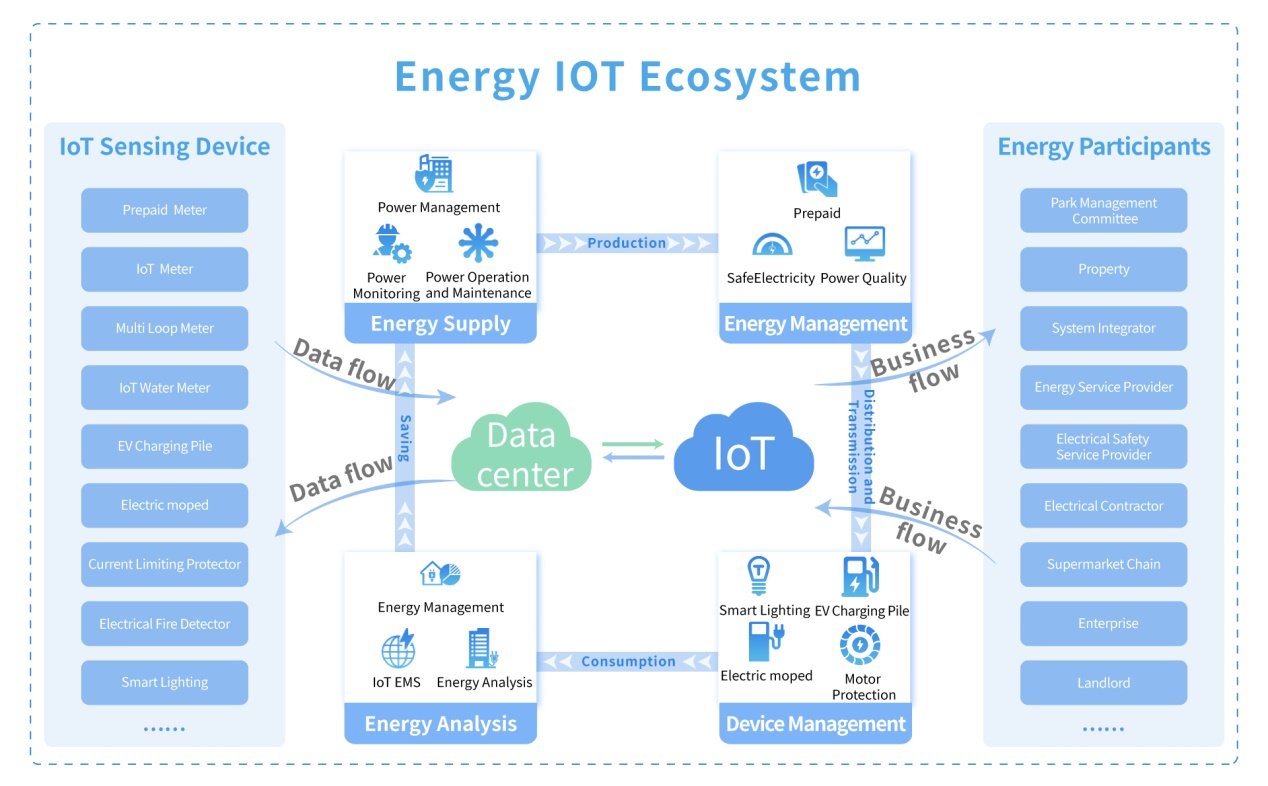
3.1 Network Structure
Acrel IoT EMS platform adopts a layered and distributed structure, which is mainly composed of three parts: perception layer (terminal acquisition equipment), network layer (communication management terminal) and platform layer (energy IoT cloud platform).
● Perception layer: Various sensors connected to the network, including multi-function meters, prepaid electricity meters, multi-loop meters, IoT electricity meters, IoT water meters, battery car charging piles, car charging piles, street light controllers, etc.
● Network layer: The intelligent gateway collects the data of the perception layer, performs protocol conversion and storage, and then uploads the data to the IoT EMS platform.
● Platform layer: Platform layer includes application server and data server, which can implement applications on web or APP.
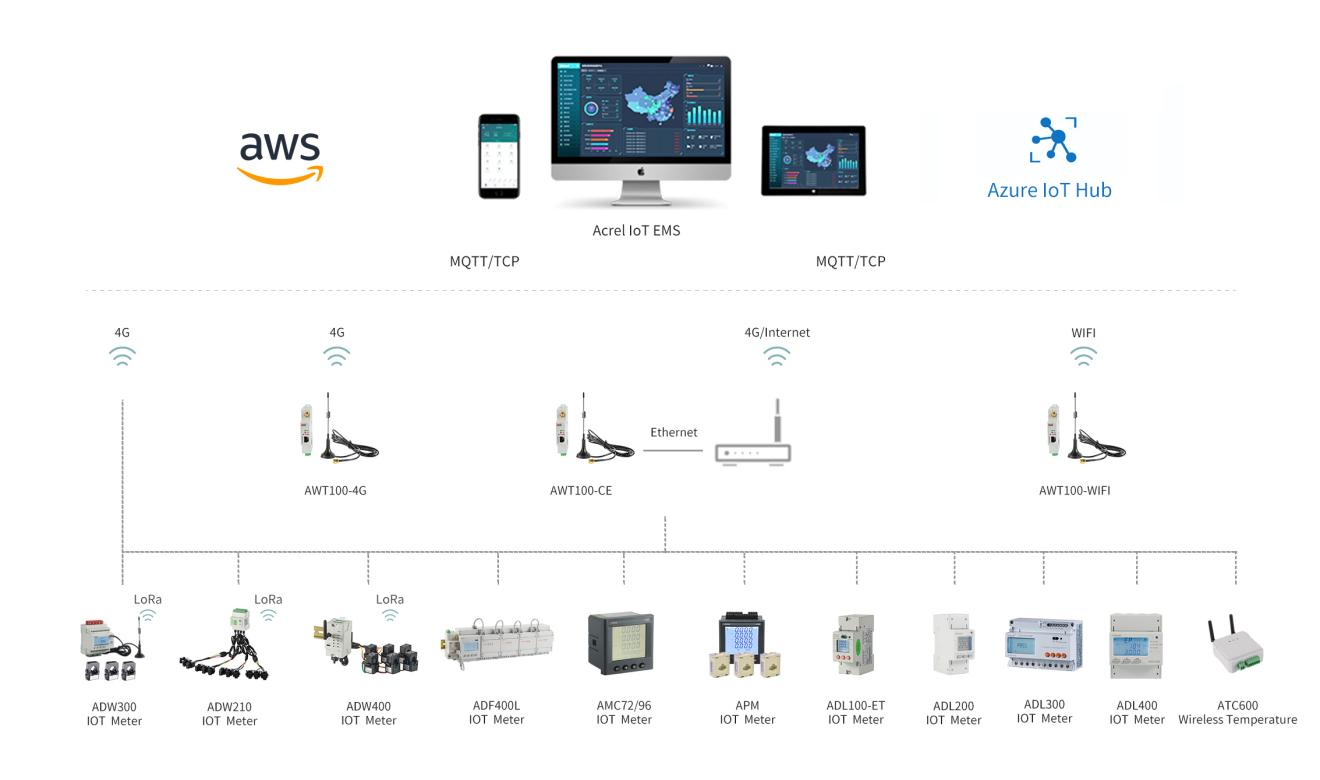
3.2 Platform Architecture
The system network structure of IoT EMS platform adopts a layered and distributed structure, including: perception layer, data layer, application layer, presentation layer and operation layer. The system architecture diagram is shown in the figure.
The sensor layer includes various products of our company, which is the bottom layer of the whole system and the basic element necessary to build the IoT cloud platform, including multi-function meters, prepaid meters, multi-loop meters, IoT meters, charging piles, street lamp controllers and so on.
The intermediate data processing platform is mainly responsible for data processing, data storage and data interaction. In order to ensure the data processing capability of the entire comprehensive platform, we store real-time data, historical data and business data in different libraries, and provide various interfaces to enable data interaction with third-party systems.
The upper application layer is the IoT EMS platform, which mainly realizes various functional applications. The platform is divided into four major sections according to the flow of energy: energy supply, energy management, equipment management and energy consumption analysis. Energy supply includes power collection, intelligent operation and maintenance. Energy management includes safe electricity consumption, power quality sub-modules. Equipment management includes intelligent lighting, prepaid, charging pile. Energy consumption analysis includes energy management, value-added service sub-modules. The platform provides users with a human-computer interaction interface through web and app, and various users of the operation layer can access and operate the platform through these two methods.
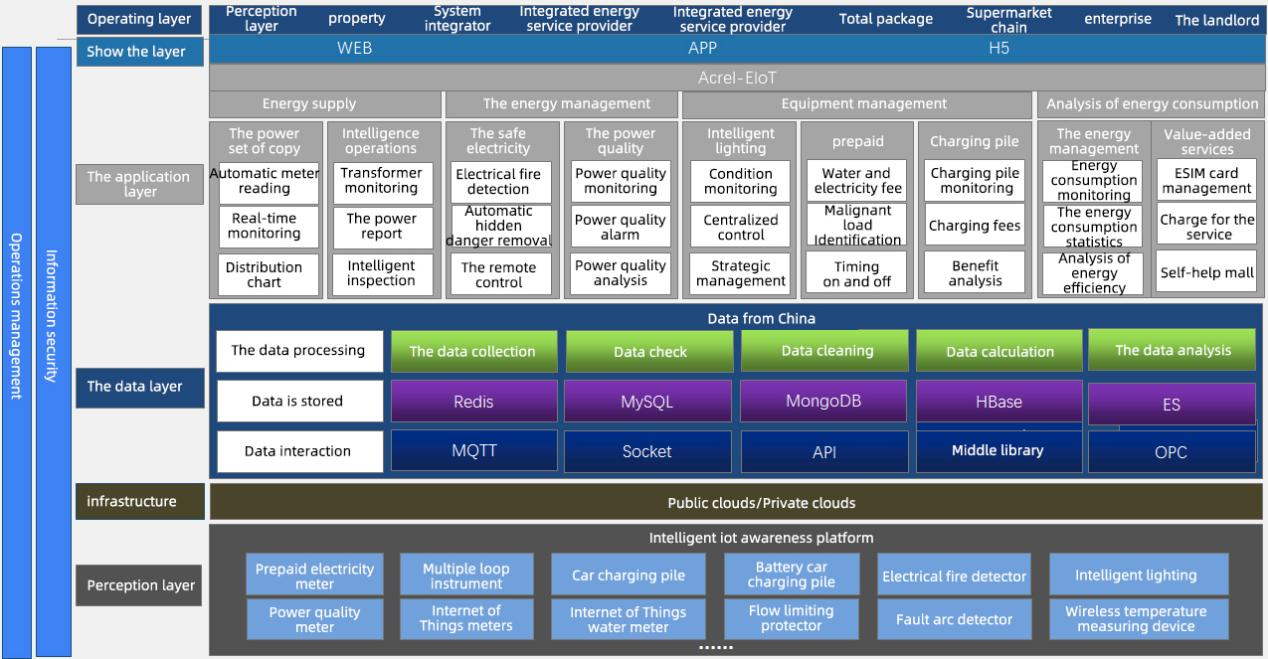
Ⅲ. Platform Function
3.1、Energy Supply
3.1.1 Power collection
The power collection module can realize the query, analysis, early warning and comprehensive display of various monitoring data to ensure the environmental friendliness of the power distribution room. In terms of intelligence, the remote measurement, remote signaling and remote control of the power supply and distribution monitoring system are realized, and the system is comprehensively detected and managed. In terms of data resource management, it can display or query the operation of each equipment in the power supply and distribution room, including historical and real-time data. According to the different needs, the daily, monthly and annual reports can be inquired and printed to improve work efficiency and save human resources.
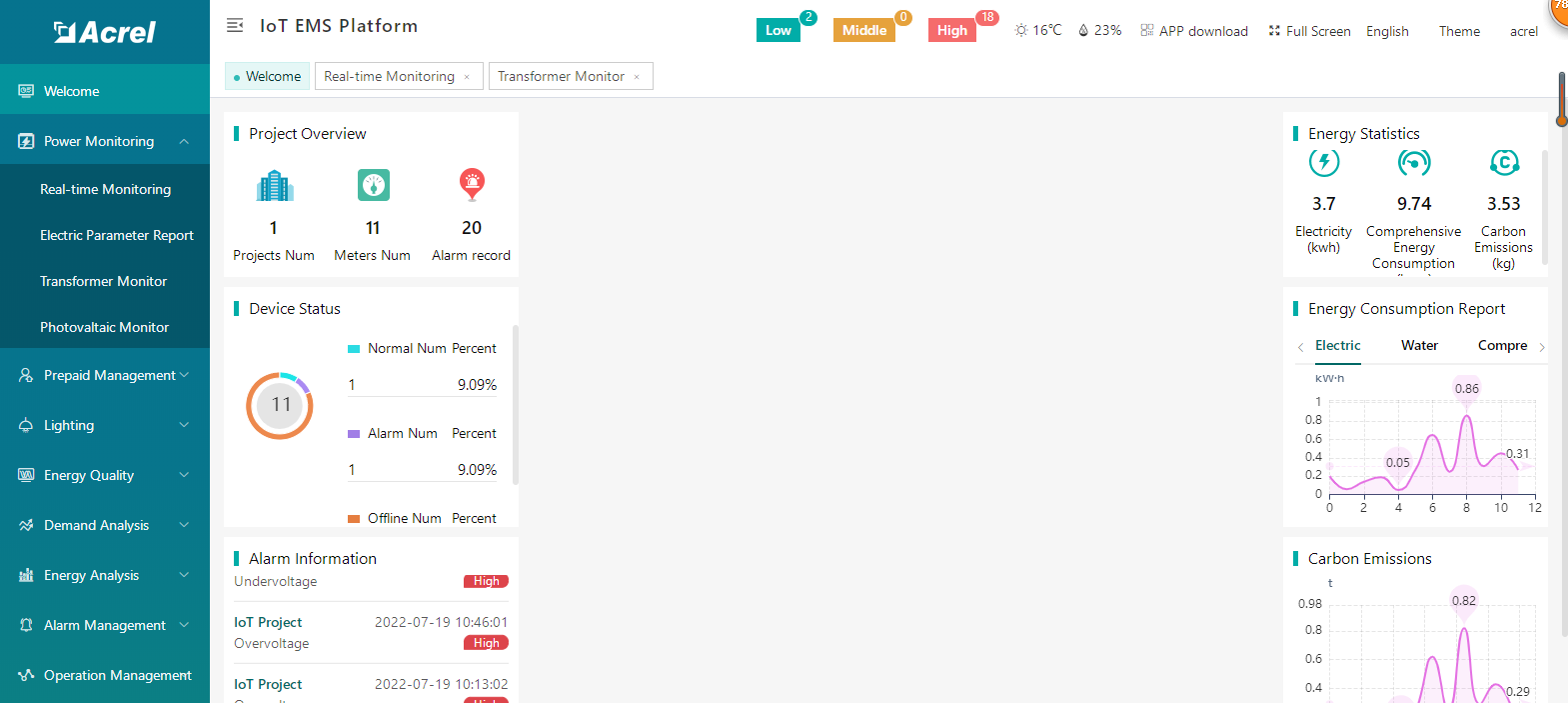
3.1.2 Intelligent operation and maintenance
The intelligent operation and maintenance module adopts multi-function power meter, wireless communication, edge computing gateway and big data analysis technology, collects field data through the intelligent gateway and stores it locally, and then pushes the data to the cloud platform regularly. The platform can simultaneously access thousands of user substation data. The data collected by the platform includes the electrical parameters and environmental data of the substation, including current, voltage and power, switching status, transformer temperature, ambient temperature and humidity, water immersion, smoke, video, access control and other information. If an abnormality occurs, an alarm will be sent through SMS and APP within 10 seconds. The platform sends the operation and maintenance tasks to the mobile phone of the designated personnel through the mobile phone APP, and tracks the operation and maintenance execution process through NFC to close the loop, improve the operation and maintenance efficiency, and immediately find the operation defects and eliminate them.
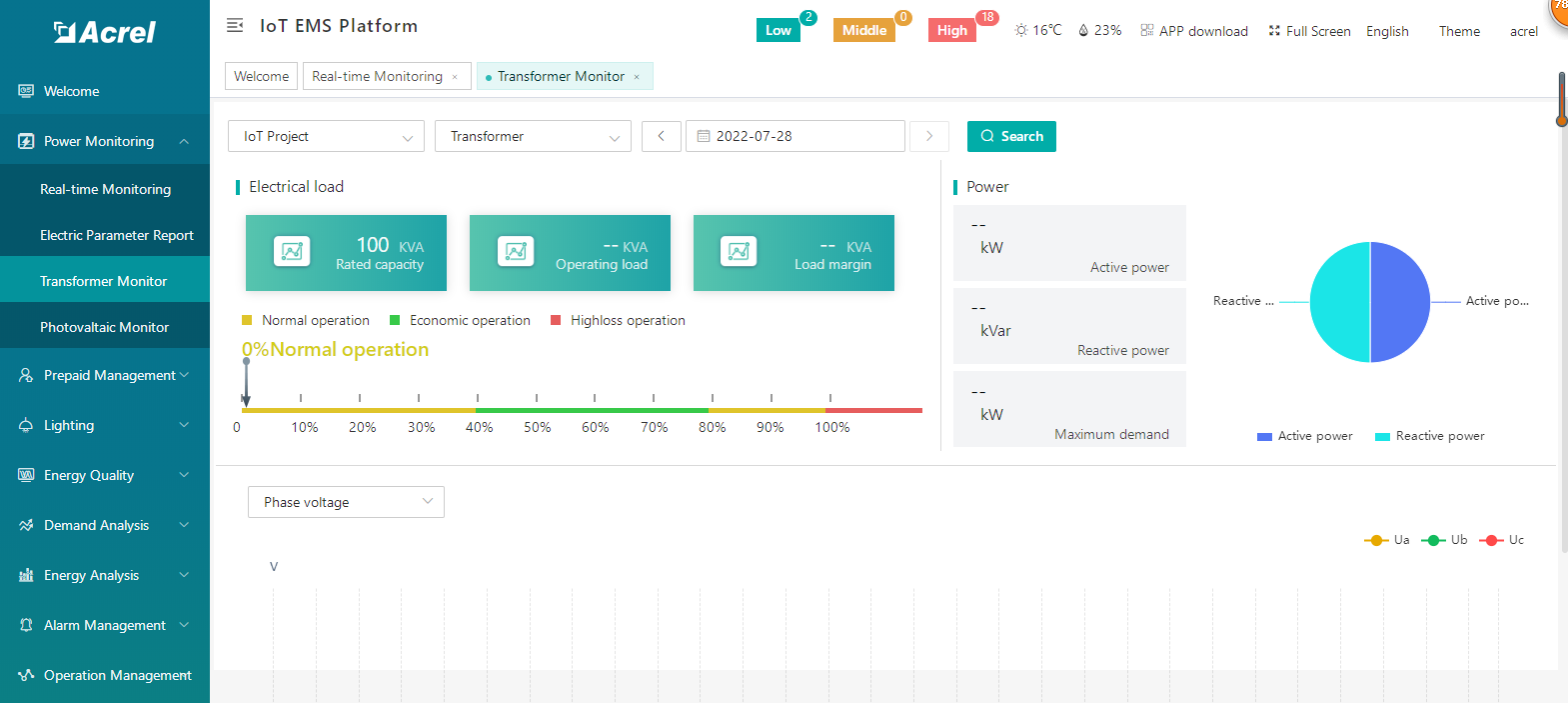
3.2、energy management
3.2.1 Electricity safety
The electricity safety module conducts uninterrupted data tracking and statistical analysis on the main factors of electrical fire (cable temperature, leakage current, load current, voltage), collects on-site data through 4G. The potential safety hazards of electrical lines and electrical equipment (such as abnormal cable temperature, overload, overvoltage, undervoltage and leakage, etc.) and timely warning through SMS, APP push, automatic voice calls, etc., to effectively prevent the occurrence of electrical fires. The system can display electrical parameters such as leakage current and cable temperature at all monitoring points, support inspection records and dispatching operations, provide potential safety hazard analysis reports, and evaluate enterprise electricity safety status in real time.
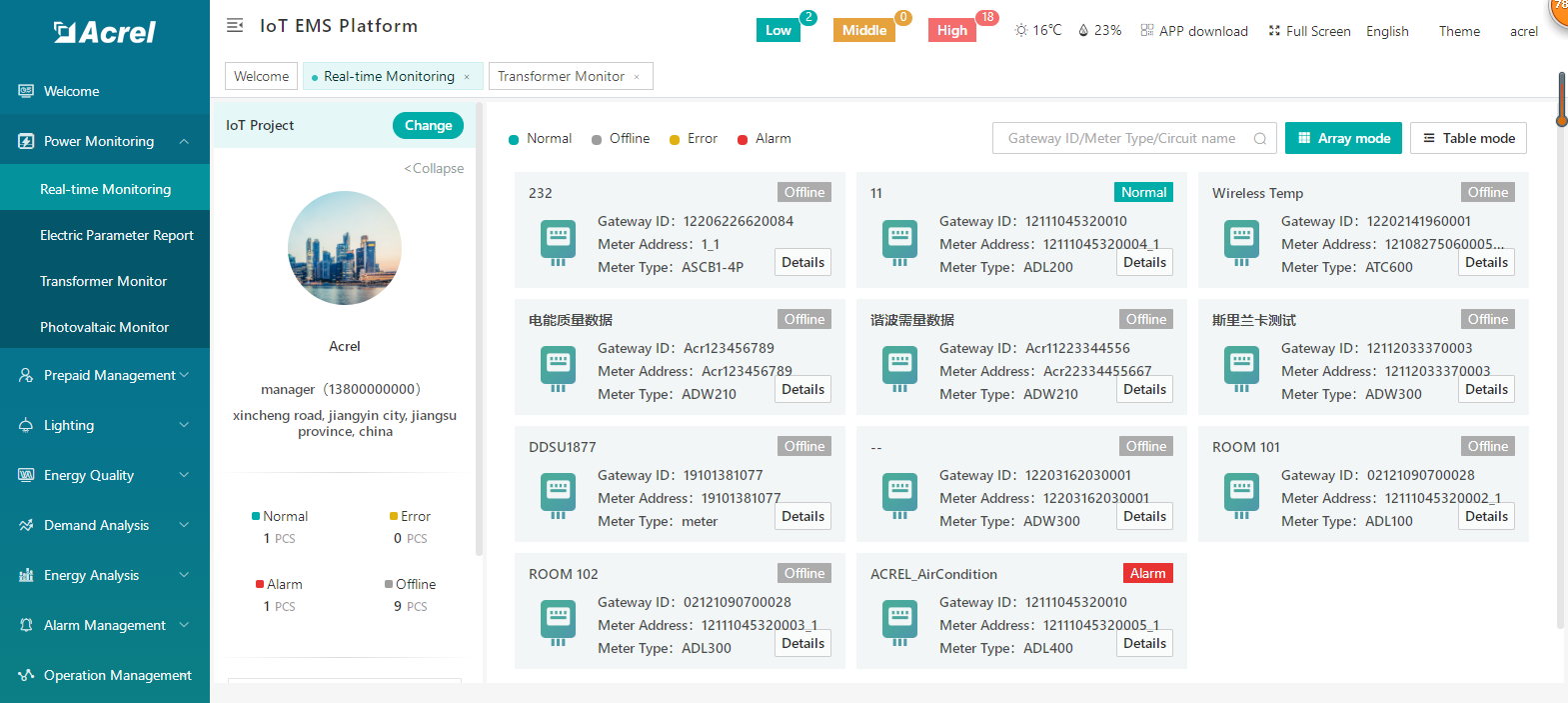
3.2.2 Power Quality
The issue of power quality has attracted more and more attention and has become one of the research hotspots of the power system. On the one hand, with the development of science and technology and the wide application of various sophisticated and complex electrical equipment, most of these equipment are very sensitive to power quality; As a result, the power quality becomes very unstable. The main purpose of power quality analysis is to determine the type and range of power signal disturbances, and to effectively adjust and compensate for the corresponding disturbance sources. Therefore, the key to improving the power quality is to obtain the information of various disturbance signal sources timely and accurately.
Power quality monitoring includes three-phase unbalance, harmonics and power factor. When the three phases are unbalanced or the power factor is too low, an alarm will be generated, and be notified to users by APP push, SMS, email and so on.
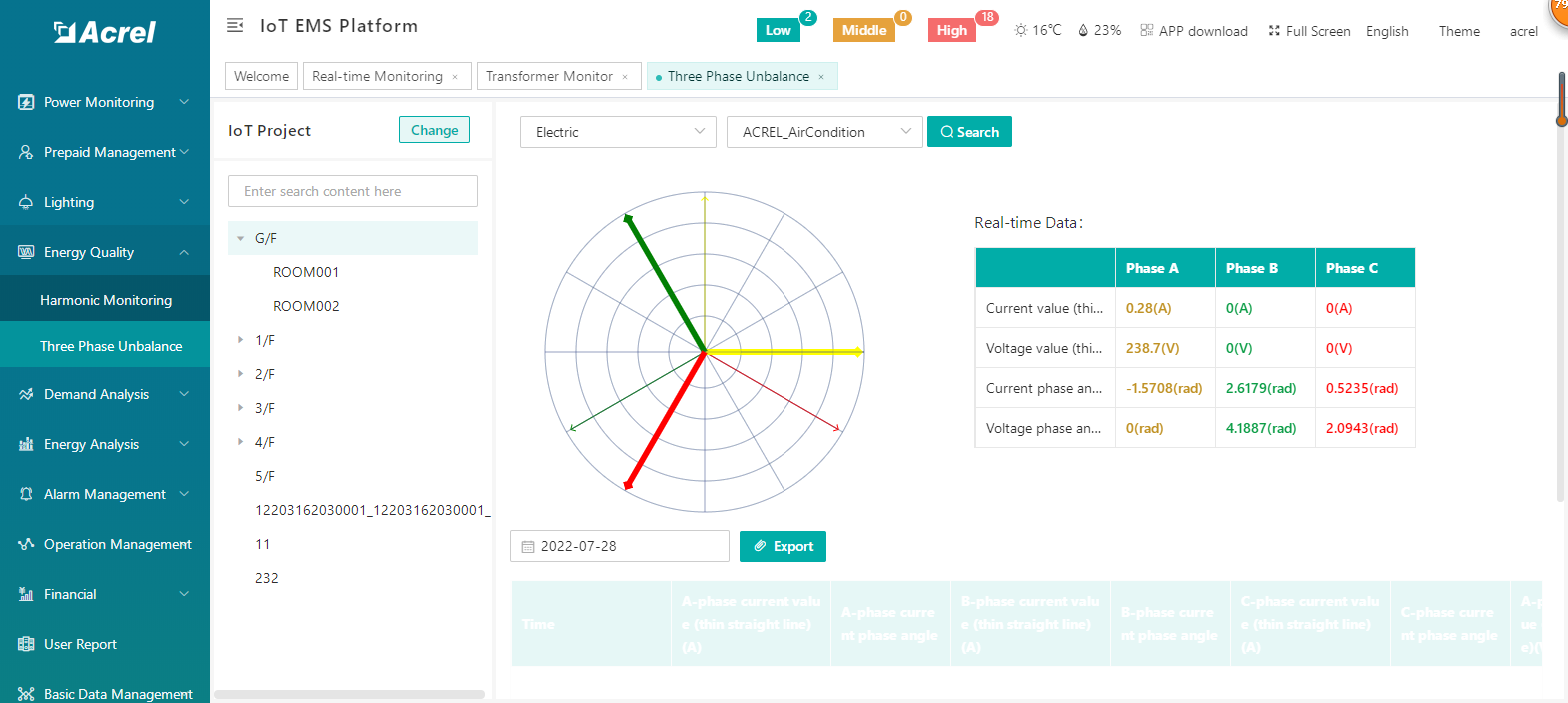
3.3. Device management
3.3.1 Smart Lighting
With the continuous improvement of people's living standards, people's requirements for working and living environment are getting higher and higher, and the requirements for lighting systems are also getting higher and higher. The energy consumption in the lighting field accounts for a considerable proportion of the total energy consumption, and saving energy and improving lighting quality are the top priorities. As an important part of electricity consumption, lighting electricity has accounted for about 10% of electricity consumption. With the rapid development of my country's national economy and the continuous improvement of people's living standards, lighting electricity consumption will continue to increase.
Smart lighting uses the Internet of Things technology to continuously monitor the power consumption status of lighting circuits installed in various areas of the city. The platform judges the working condition of the lamps by monitoring the current and voltage value of the lighting circuit. Any abnormal working state can be monitored by the platform, and the warning and alarm information can be pushed through the mobile APP, SMS, and email, quickly reach the person in charge, remind the operator that the contactor trips, the power supply loses voltage, etc.

3.3.2 Prepaid management
The prepaid electricity function can be used for various commercial complexes, communities, office buildings, office buildings, hotel-style apartments and other properties, logistics management departments of schools, factory dormitories, supermarket chains, and large-scale properties. At present, prepaid water and electricity have been successfully used in the above scenarios and have been running stably for many years. It is suitable for the management of electricity prepaid by property companies for residential, office and shop tenants, or the prepaid electricity and electricity consumption of student dormitories by schools and security control system.
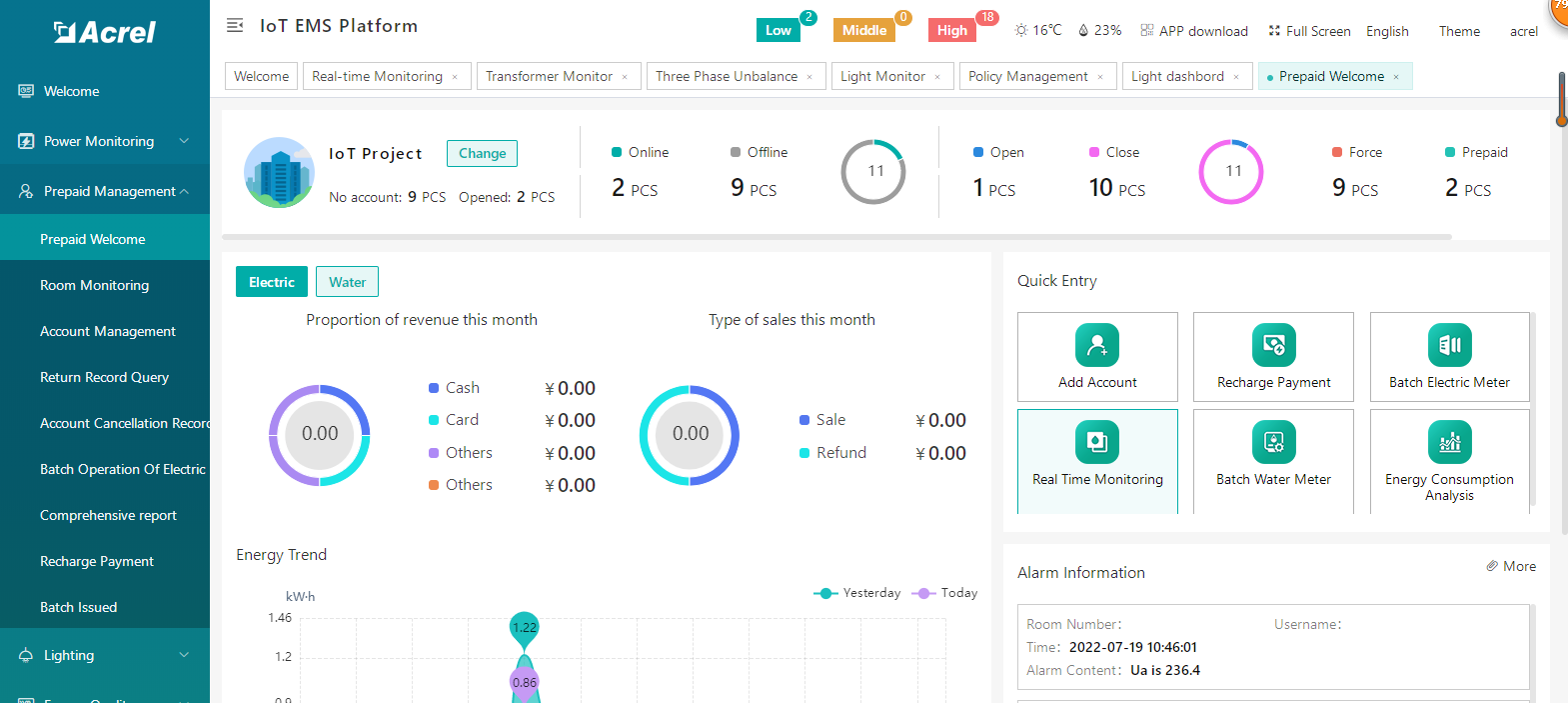
3.3.3 Car/battery car charging operation
Electric vehicles have become a widely used green energy transportation. At the same time, the number of electric bicycles is increasing, which solves the short-distance travel problem of people. However, news of safety and fire accidents related to electric bicycles are also frequent, and there is a trend of increasing year by year. It has brought great losses to the society and has become a hidden danger to the safety of people's lives and properties. Based on the hazards and characteristics of electric bicycle fires, government departments at all levels have issued documents to regulate the parking and charging behaviors of electric bicycle fires. The charging operation function module of the car/battery car continuously collects and monitors the data of the charging pile site and each charging pile connected to the system through the Internet of Things technology, and at the same time protects against various faults such as over-temperature protection of the charger and over-voltage of the input and output of the charger, undervoltage, insulation detection failure and a series of faults for early warning. After the user scans the QR code through the APP, the system initiates a charging request and controls the charging pile corresponding to the QR code to complete the charging process of the electric vehicle. The charging pile can be equipped with wireless module to connect to the Internet, cooperate with encryption technology and key distribution technology, and directly connect with the cloud based on the data exchange protocol based on TCP/IP.
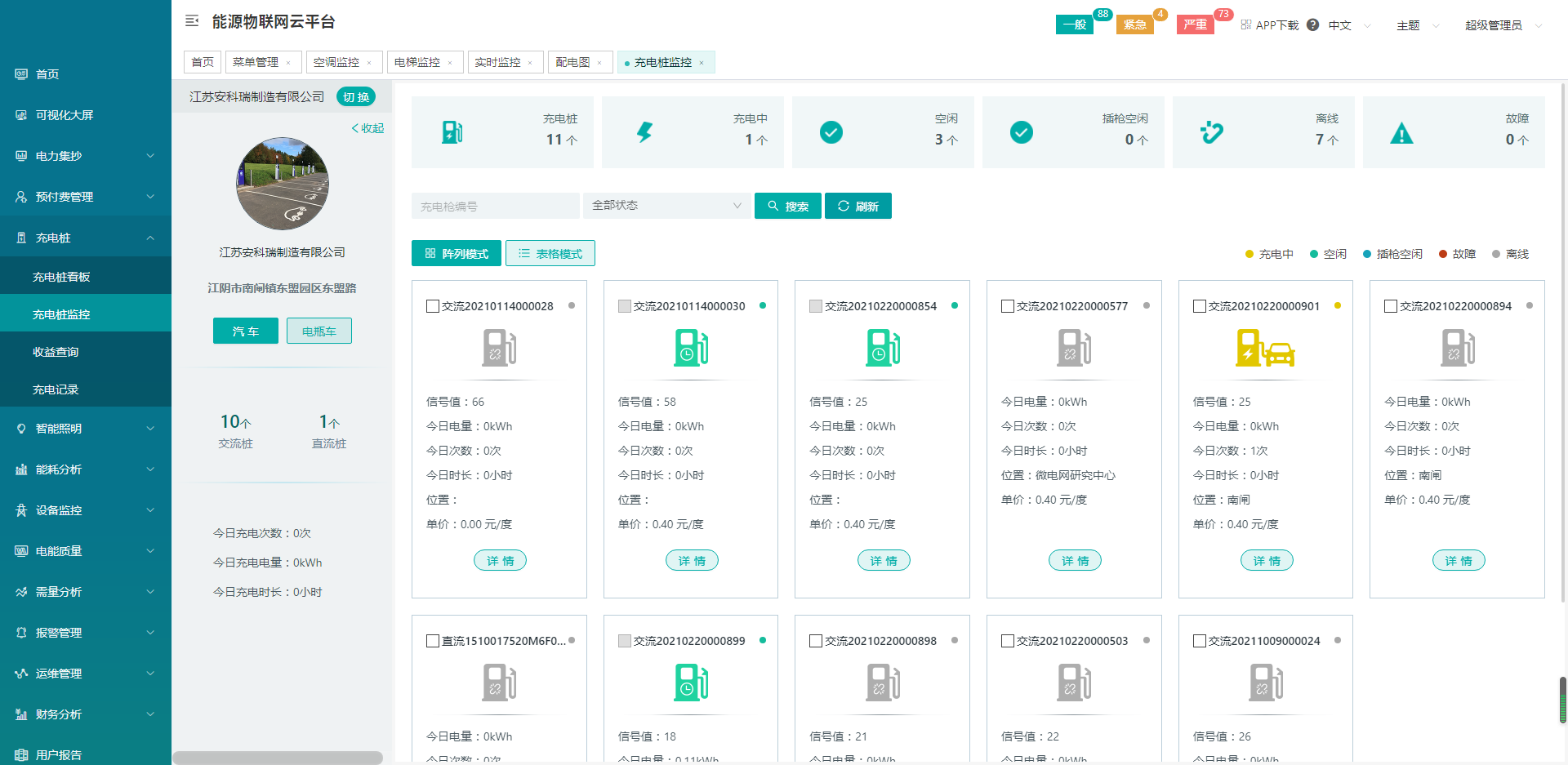
3.4. energy analysis
3.4.1 energy management
In order to steadily advance the dual carbon goal, under the background of "dual control" of energy consumption intensity and total consumption, enterprises need to consider how to deal with the dual control of energy consumption to ensure normal production. Most of the existing enterprises still use the "individual planning, independent design, independent operation" mode of various energy supply systems such as electricity, water, gas, cooling, and heat. Insufficient measurement equipment is generally detected; the measurement accuracy of measurement equipment is not high and the measurement data is inaccurate; the reliability of manual meter reading is low; it is difficult to effectively monitor and evaluate the energy efficiency of major energy-consuming equipment; Provide reliable reference data; lack an effective enterprise energy efficiency evaluation index system, and it is difficult to implement energy consumption management measures.
The energy management module adopts automation and information technology to realize the automatic and scientific management of the whole process from energy data collection, process monitoring, energy medium consumption analysis, energy consumption management, etc. Therefore it organically combines the whole process of energy management, energy production and use, and uses advanced data processing and analysis technology to conduct offline production analysis and management, to achieve unified scheduling of the entire plant's energy system, and to optimize energy medium balance and effective use. And it also improves energy quality, reduces energy consumption, and achieves the purpose of saving energy and reducing consumption and improving the overall energy management level.
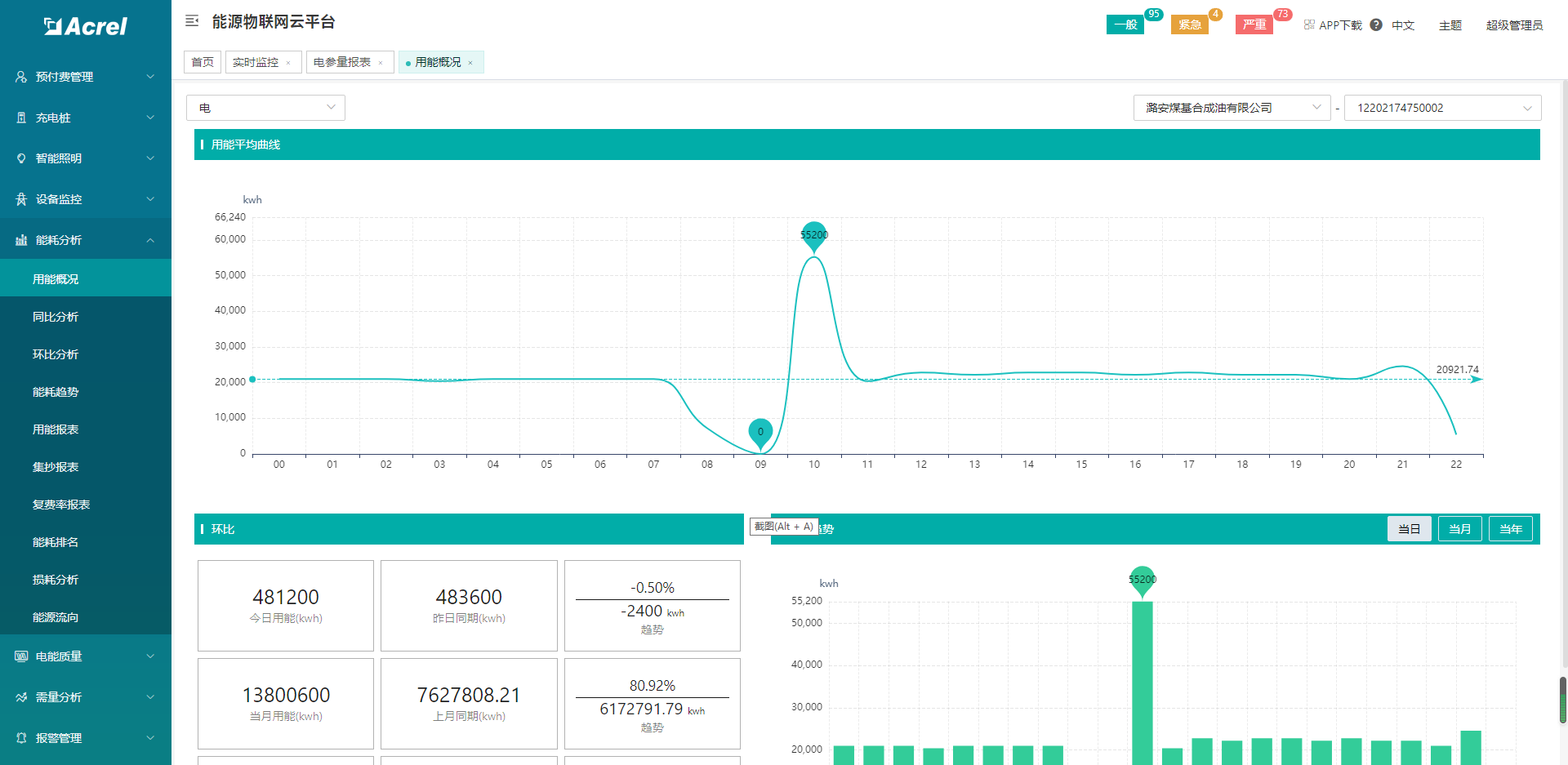
3.4.2 Value-added services
(1)Industrial configuration
The traditional industrial automation configuration application development method requires developers to have the ability to write code, understand the concepts and use methods of related development frameworks. And this development method needs a long development cycle and very high requirements for developers. At the same time, the traditional industrial automation configuration applications are deployed in the industrial field, and the deployment convenience and accessibility are very low.
With the rapid development of the Industrial Internet, application requirements are often updated and iterated very quickly, and equipment manufacturers often do not have the relevant industrial configuration software development background, which makes the development and update speed of industrial configuration software very slow, often unable to meet the needs of rapid business growth. At the same time, the access to the industrial configuration software is no longer limited to the industrial site, and the demand for access from outside the industrial site is also increasing.
The industrial configuration module in the IoT EMS platform solves the problems of low deployment and low accessibility of traditional industrial automation configuration applications. Users can adjust the configuration screen components by dragging and dropping the mouse in the development tool. attribute, location, size, etc., and built-in rich configuration component library, so that users do not need code writing ability, no technical background of industrial automation configuration software development, but also can easily develop industrial configuration interface, and also support data Display, remote control and other functions.
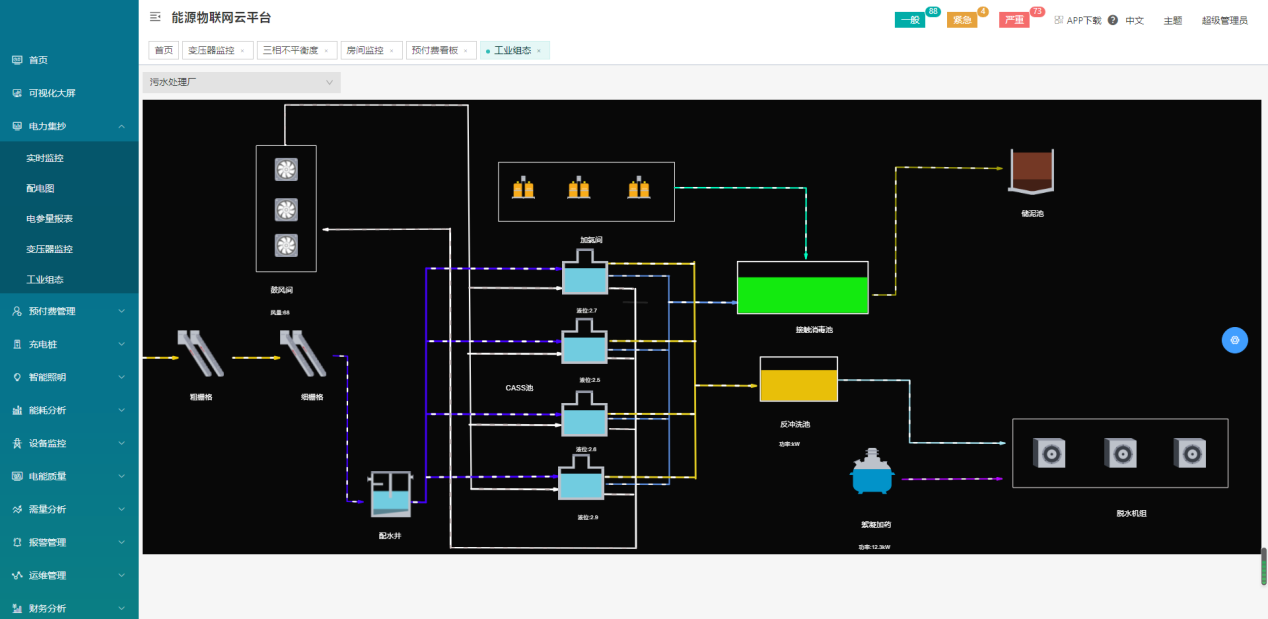
(2)3D visualization
3D visualization technology realizes multi-dimensional visualization through virtual simulation, provides customers with digital services, helps enterprises in two-way management of energy economy, and improves the level of energy management. The main functions that can be realized are: real-time synchronization of information in each area; global control of energy consumption in each area; visual monitoring of equipment operation status; intelligent inspection, automatic analysis of equipment operation, power quality, electrical safety, and abnormal energy consumption on the inspection path etc., and record the inspection results.
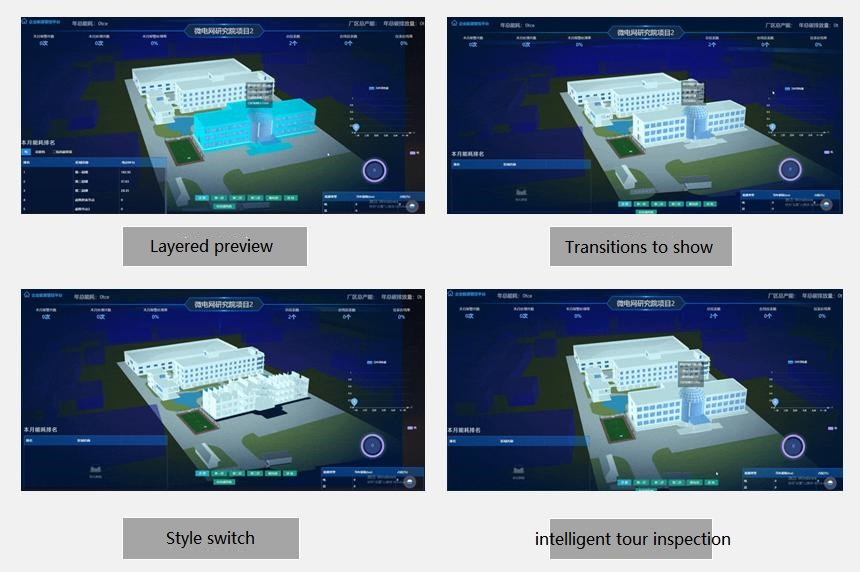
Ⅴ. Summarize
As an industrial development form combining traditional energy industry and Internet of Things technology, energy Internet of Things is an important strategic support for the integrated development of national energy revolution and digital revolution. The Energy Internet of Things is an extension of the Internet of Things to the process of energy production, configuration and consumption. With the rapid development of modern information technologies such as the "Big Cloud IoT Smart Chain", the Power Internet of Things integrates information, communication, digital technology, and power system development. All aspects of transmission, transformation, distribution, and electricity consumption are deeply integrated to realize multi-directional monitoring of status, intelligent information processing and intelligent interconnection, human-computer interaction, and intelligent services.
Post time: Aug-01-2022




